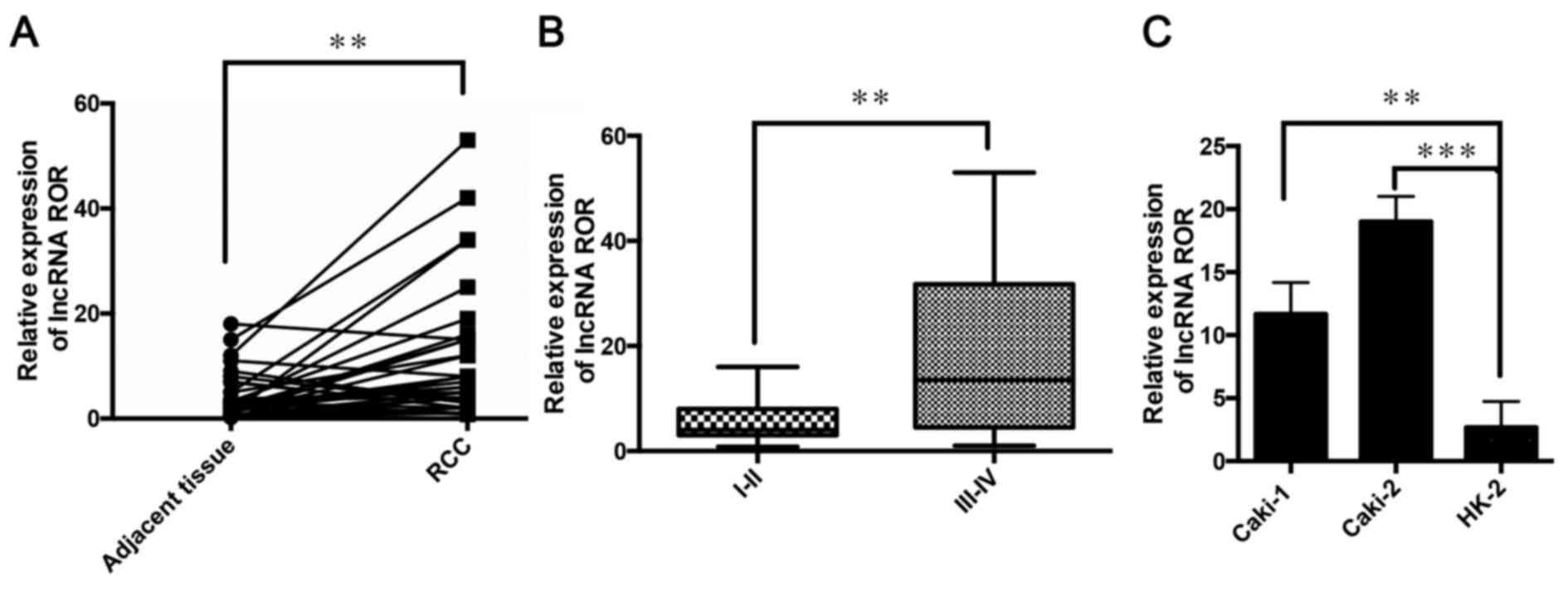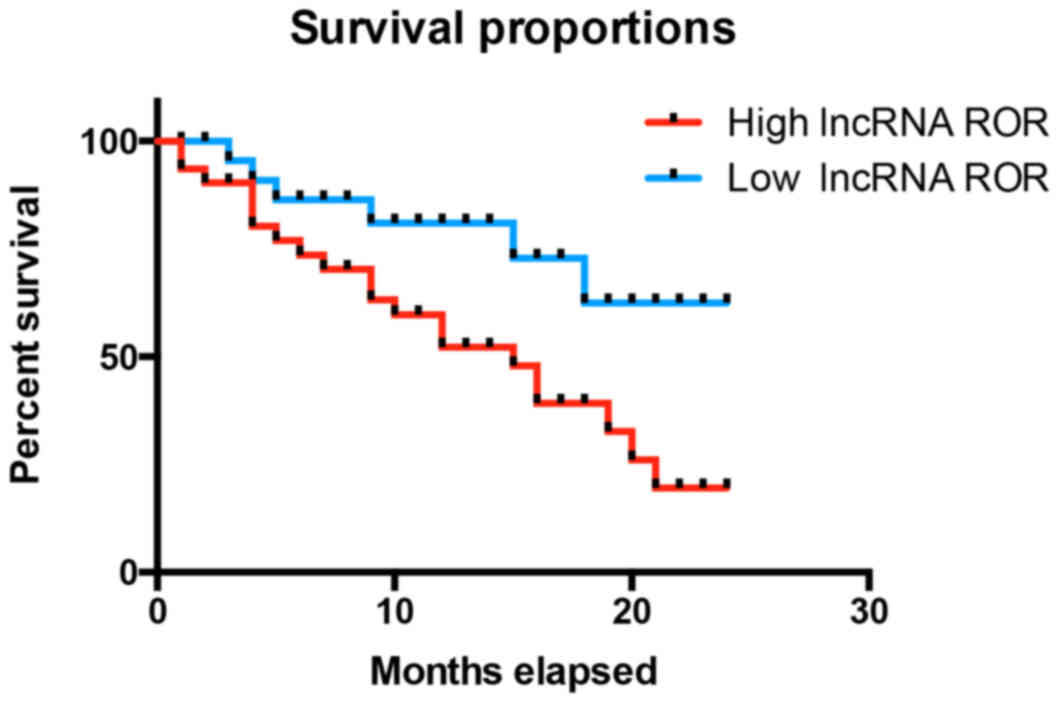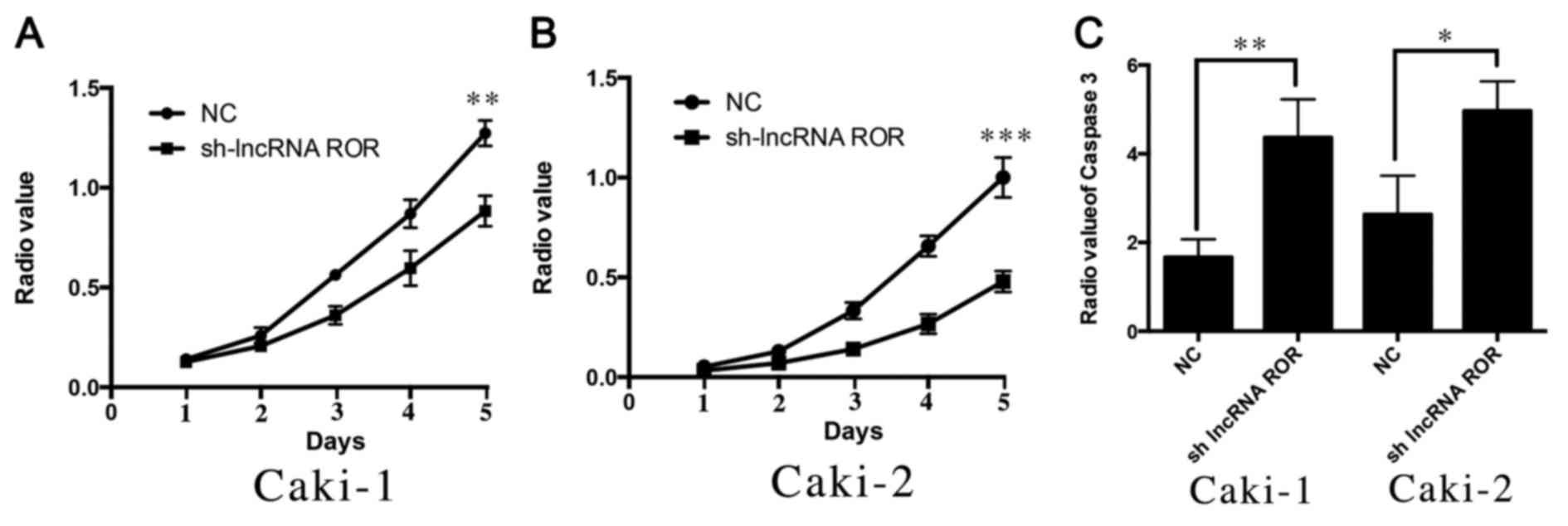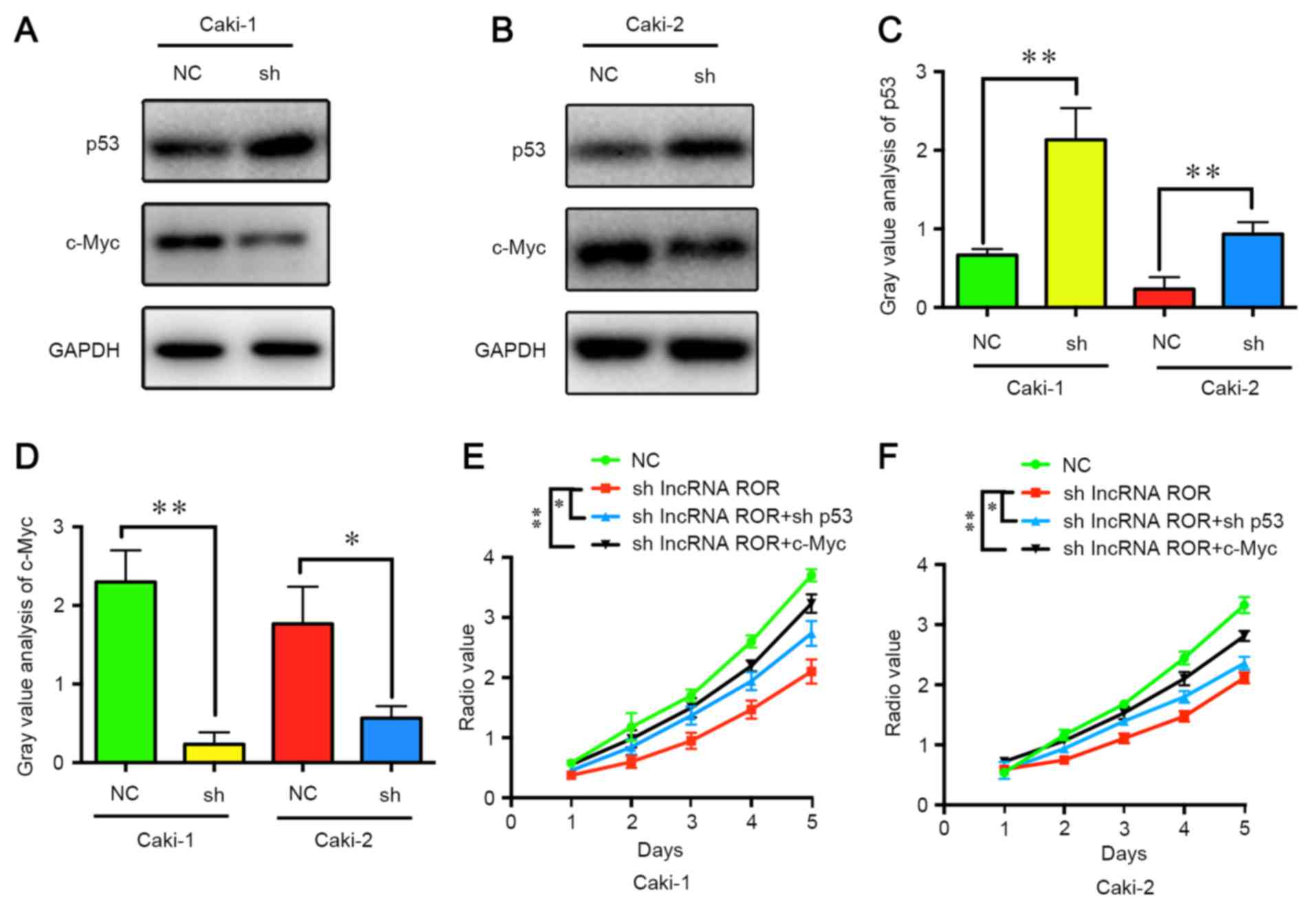lncRNA ROR promotes the proliferation of renal cancer and is negatively associated with favorable prognosis
- Authors:
- Published online on: October 12, 2017 https://doi.org/10.3892/mmr.2017.7775
- Pages: 9561-9566
Abstract
Introduction
Renal cell carcinoma (RCC) is one of the third most common types of urological cancer worldwide (1). According to previous report, the incidence of RCC has increased in the last 20 years (2% per year), and patients with advanced RCC experience reduced survival rates (2,3). Chemotherapy, radiotherapy and surgery are the most common treatment methods for RCC, however, response to treatment remains poor (4). In addition, there are few effective and specific biomarkers for RCC, which is the reason for failed early detection and treatment of RCC. As a result, it is necessary to identify sensitive biomarkers for RCC and to develop novel targets for the treatment of RCC.
Previous studies have found that long non-coding RNAs (lncRNAs) are important in the development and progression of cancer (5,6). lncRNAs are a type of non-coding RNA, which are >200 nucleotides in length. Certain lncRNAs have been shown to regulate the proliferation, migration and drug resistance of human cancer. Hu et al reported that lncRNA GAPLINC regulates the malignant activity of gastric cancer cells by regulating the expression of CD44 (7). Sun et al found that lncRNA HOXA11-AS promotes the proliferation and invasion of gastric cancer by regulating the histone methylation state and sponging for microRNA (miR)-1297 (8). Yuan et al found that lncRNA DANCR increases the stemness of hepatocellular carcinoma by regulating the expression of CTNNB1 via inhibiting miR-214, miR-320a and miR-199a (9). These findings indicate that lncRNAs may be novel potential targets for treating cancer. However, the function of lncRNAs in RCC remains to be fully elucidated.
lncRNA ROR has been reported as an oncogene in several types of cancer. Studies have shown that lncRNA ROR can promote the proliferation and invasion of breast cancer via targeting miR-145 and miR-205, regulating the targets of these miRNAs (10,11). In addition, previous studies have shown that lncRNA ROR can regulate the sensitivity to radiotherapy and chemotherapy in cancer treatment via the p53/miR-145 signaling pathway, indicating that lncRNA ROR can be used as a novel target in cancer treatment (12). Wang et al also found that lncRNA ROR can predict outcome in patients with gallbladder cancer, and promotes the proliferation, migration and invasion of gallbladder cancer (13). Huang et al found that lncRNA ROR can promote cell proliferation and tumorigenesis by promoting the stability of c-Myc mRNA via binding hnRNP I and AU-rich element RNA-binding protein 1 (AUF1) (14). These studies show that lncRNA ROR is involved in regulating the malignant activities of different types of cancer, indicating that lncRNA ROR may be a potential treatment target. However, the role of lncRNA ROR in RCC remains to be elucidated.
The present study aimed to investigate the expression of lncRNA ROR in RCC tissues and adjacent tissues, and to examine the clinical characteristics of lncRNA ROR in RCC. The possible mechanism underlying the effect of lncRNA ROR on RCC was also investigated. The results indicated that lncRNA ROR may offer potential as a novel biomarker for the diagnosis of RCC and a target for its treatment.
Materials and methods
Clinical sample collection and preparation
A total of 36 RCC tissues and matched adjacent non-tumor tissues were collected from patients who underwent radical nephrectomy in the Department of Urology, The first Affiliated Hospital of Liaoning Medical University (Jinzhou, China), between June 2014 and July 2015. None of these patients had received chemotherapy or radiotherapy prior to collection. The samples were cut into small sections following washing with the RNase-free phosphate-buffered saline (PBS), and then collected and stored in the liquid nitrogen. The clinical stages of the RCC tissue samples were confirmed according to the TNM classification (4). All patients were informed of the use of samples and written consent was provided. The entire protocol was approved by the Institutional Review Board of The First Affiliated Hospital of Liaoning Medical University.
Cell culture
The immortalized normal human proximal tubule epithelial cell line (HK-2) and renal cancer cell lines (Caki-1 and Caki-2) were the cells used for investigation in the present study, which were purchased from the Cell Bank of Type Culture Collection of Chinese Academy of Sciences (Shanghai, China). The HK-2 cell line was cultured in KSFM medium (Hyclone; GE Healthcare Life Sciences, Logan, UT, USA), and Caki-1 and Caki-2 were cultured in RPMI 1640 medium (Hyclone, GE Healthcare Life Sciences). These media were supplemented with 10% FBS (Gibco; Thermo Fisher Scientific, Inc., Waltham, MA, USA), and 1% penicillin and streptomycin (Beyotime Institute of Biotechnology, Haimen, China). The cells were maintained at 37°C with 5% CO2.
Plasmid transfection
The cells were plated in a six-well plate at 70–90% confluence (~1×105 target cells), to which fresh serum-free culture medium was added 2 h prior to transfection. The plasmids used to knockdown the expression of lncRNA ROR in renal cancer cell lines (shRNA: GATCCCCCCTGAGAGTTGGCATGAATTTCAAGAGAATTCATGCCAACTCTCAGGTTTTTC) were provided by Sangon Biotech (Shanghai, China). The plasmids were transfected into cells using Lipofectamine 2000 (Invitrogen; Thermo Fisher Scientific, Inc.) for 12 h according to the manufacturer's protocol. The fluorescence was observed after 24 h.
RNA extraction and reverse transcription-quantitative polymerase chain reaction (RT-qPCR) analysis
Total RNA from the cells and clinical samples were extracted using RNAiso Plus (Takara Bio Inc., Otsu, Japan), according to the manufacturer's protocol. The RNA was then reverse transcribed into cDNA using a PrimeScript™ RT reagent kit with gDNA Eraser, according to the manufacturer's protocol (Takara Bio, Inc.). The RT-qPCR procedure (2 µl cDNA, 1 µl forward primer, 1 µl reverse primer, 0.4 µl ROX, 5.6 µl RNase-free Water and 10 µl SYBR) was performed on a Real time PCR system (Applied Biosystems; Thermo Fisher Scientific, Inc.), as follows: 10 min at 95°C, 40 cycles of 10 sec at 95°C, 30 sec at 60°C, and 20 sec at 72°C. GAPDH was used as a control. The relative expression of lncRNA ROR (forward: 5′-CCAGGACAATGAAACCAC-3′; reverse: 5′-AGGAGCCCAAAGTAACAG-3′) was calculated using the comparative cycle threshold 2−ΔΔCq method, with GAPDH (forward: 5′-GGTGAAGGTCGGAGTCAACG-3′; reverse: 5′-CAAAGTTGTCATGGATGHACC-3′) as the endogenous control for data normalization.
Cell Counting Kit-8 (CCK-8) assays
The target cells were seeded into a 96-well flat-bottomed plate, each well containing 3,000 cells in 200 µl cell suspension. A 20-µl volume of CCK8 (Dojindo Molecular Technologies, Inc., Kumamoto, Japan) was added to each well and cultured for 2 h at 37°C. The absorbance value of each well at 450 nm was measured and recorded, which represented the proliferation of the target cells. Each experiment included five replicates and was repeated three times.
Analysis of apoptosis
The activity of Caspase 3 was measured to determine the level of apoptosis. A Caspase-3 Colorimetric Activity Assay kit (EMD Millipore, Billerica, MA, USA) was used to detect the level of apoptosis of the target cells, according to the standard assay protocol.
Western blot analysis
The cells were washed three times with pre-cooled PBS. Total cell proteins were extracted using RIPA buffer containing the protein inhibitor, PMSF. Protein concentrations were assessed using the standard curve established with bovine serum albumin (Beyotime Institute of Biotechnology, Beijing, China). The total proteins (30 µg) were subjected to sodium dodecyl sulfate polyacrylamide gel electrophoresis (SDS-PAGE) on a 10% denaturing gel. Following SDS-PAGE, the proteins were transferred onto a PVDF membrane (EMD Millipore). The membrane was inhibited with 5% non-fat milk for 2 h at room temperature. This was followed by incubation of the membrane with primary antibodies at 4°C overnight. The source and dilution of these antibodies were as follows: p53 (ab32049; 1:1,000; Abcam, Cambridge, MA, USA); c-Myc (ab39688; 1:1,000; Abcam); GAPDH (ab8245; 1:1,000; Abcam). The membrane was then washed in TBS-T (Wuhan Boster Biological Technology, Ltd., Wuhan, China) for 5 min, and he membrane was incubated with secondary antibody (A16072; 1:1,000; and A16104; 1:1,000; Thermo Fisher Scientific, Inc.). The blots were visualized using an ECL chemiluminescence detection system, and protein bands were quantified using densitometric analysis with Quantity One software version 4.62 (Bio-Rad Laboratories, Inc., Hercules, USA).
Statistical analysis
All experiments were performed at least three times and data are presented as the mean ± standard deviation. Statistical analyses were performed using Student's t-test or one-way analysis of variance using GraphPad Prism 5 (GraphPad Software, Inc., La Jolla, CA, USA). Survival analysis was performed using the log-rank test in GraphPad. P<0.05 was considered to indicate a statistically significant difference.
Results
Expression levels of lncRNA ROR are high in RCC tissues and RCC cell lines
The relative expression of lncRNA ROR was determined in 36 patients with RCC using RT-qPCR analysis. It was found that the expression of lncRNA ROR was high in the RCC tissues, compared with the adjacent non-tumor tissues (Fig. 1A). It was also found that the expression of lncRNA ROR was higher at clinical stages III and IV, compared with that at clinical stages I and II (Fig. 1B). The expression of lncRNA ROR was also detected in Caki-1 and Caki-2 RCC cell lines and the HK-2 normal human proximal tubule epithelial cell line. It was found that the expression levels of lncRNA ROR in the RCC lines were higher, compared with that in the HK-2 cell line (Fig. 1C). These results indicated that lncRNA ROR was expressed at high levels in the RCC tissues and cell lines, and that lncRNA ROR may be involved in the progression and development of RCC.
High expression of lncRNA ROR predicts poor patient prognosis
To further examine the effect of lncRNA ROR in RCC, the present study examined the association between the expression of lncRNA ROR and the survival rates of patients with RCC. It was found that the patients with RCC and high expression levels of lncRNA ROR had reduced survival rates, compared with patients with low expression levels of lncRNA ROR (Fig. 2). As shown in Table I, it was found that the expression of lncRNA ROR was closely associated with tumor size and the clinical stage of RCC, however, no significant associations were found between the expression of lncRNA ROR and age or gender. These results indicated that lncRNA ROR was closely associated with tumor size in RCC. Taken together, these results suggested that the expression of lncRNA ROR was closely associated with the prognosis of patients with RCC and may be associated with proliferation.
Table I.Associations between the expression level of lncRNA ROR and clinical characteristics of patients. |
Knockdown of lncRNA ROR inhibits proliferation and promotes apoptosis of RCC cells
As described in the results above, it was found that lncRNA ROR may be associated with the proliferation of RCC. To further investigate the possible effect of lncRNA ROR on the proliferation of RCC cells, the present study used a CCK8 assay to detect changes in the proliferation ability of Caki-1 and Caki-2 cells following the suppression of lncRNA ROR. It was found that the suppression of lncRNA ROR led to a decrease in the proliferation ability of the Caki-1 and Caki-2 cells (Fig. 3A and B). The apoptosis of Caki-1 and Caki-2 was then detected following suppression of the expression of lncRNA ROR. It was also found that apoptosis was increased following transfection with short hairpin (sh)-lncRNA ROR, compared with that in the control group (Fig. 3C). These findings indicated that knockdown of the expression of lncRNA ROR inhibited the proliferation and promoted the apoptosis of RCC cells.
lncRNA ROR promotes the proliferation of RCC cells via suppressing the expression of p53 and increasing the expression of c-Myc
Although the present study demonstrated that lncRNA ROR promoted the proliferation of RCC, the detailed mechanism remains to be fully elucidated. According to a previous study, lncRNA ROR promotes the resistance of human colorectal cancer cells to radiotherapy via suppressing the expression of p53. In addition, Huang et al (14) demonstrated that lncRNA ROR promotes the expression of c-Myc to increase cell proliferation and tumorigenesis. In the present study, the expression levels of c-Myc and p53 were detected following the suppression of lncRNA ROR. It was found that the expression of p53 was increased, whereas the expression of c-Myc was decreased (Fig. 4A-D). It was also found that the suppression of p53 and the overexpression of c-Myc restored the proliferation ability of the RCC cells (Fig. 4E and F). These results indicated that lncRNA ROR promoted the expression of c-Myc and suppressed the expression of p53 in the RCC cells, leading to cell proliferation.
Discussion
RCC remains one of the leading causes of cancer-associated mortality worldwide; therefore, novel targets for its treatment, prognosis and diagnosis are required to improve clinical treatment. An increasing number of studies have found that lncRNA is involved in the development and progression of different types of tumor, which may be developed as novel targets and biomarkers for cancer treatment. Wang et al (15) has found that a panel of four lncRNAs (BANCR, NR_026817, NR_029373 and NR_034119) can be used to detect colorectal cancer. In addition, certain lncRNAs, including lncRNA MALAT1, HOTAIR, lncRNA CCAT2 and H19, have shown potential in predicting prognosis, survival rates and the effect of treatment (16). Among the lncRNAs, lncRNA ROR has been investigated extensively, as its function is important in the development of different types of cancer. However, the effect of lncRNA ROR in the development of RCC has note been fully elucidated, requiring further investigation.
In the present study, the expression of lncRNA ROR in patients with RCC was first investigated. It was found that the expression of lncRNA ROR was high in RCC tissues, compared with that in adjacent non-tumor tissues, determined using RT-qPCR analysis. The results also indicated that the expression of lncRNA ROR was closely associated with patient survival rates. Patients with RCC and higher expression levels of lncRNA ROR experienced reduced survival rates, compared to those with lower expression levels of lncRNA ROR. The expression of lncRNA was also closely associated with tumor size, suggesting that lncRNA ROR affected the proliferation of RCC cells. Taken together, these results indicated that lncRNA ROR is an independent prognostic factor for patients with RCC, and is important in the proliferation of RCC.
To further confirm the above findings, the effect of lncRNA ROR on the proliferation of RCC cells was determined. Changes in the proliferation ability of the Caki-1 and Caki-2 RCC cells were detected following the suppression of lncRNA ROR. The proliferation of the cells was suppressed, indicating that lncRNA ROR promoted the proliferation of the Caki-1 and Caki-2 cells. This result was in agreement with the clinical findings.
Previous studies have found that lncRNA ROR promotes the proliferation of different types of cancer, including the proliferation ability of gastric cancer, gallbladder cancer and nasopharyngeal carcinoma, which indicates that lncRNA ROR is important in controlling the proliferation of cancer (13,17,18). However, the detailed mechanism underlying the effect of lncRNA ROR in regulating proliferation remains to be elucidated. lncRNA ROR was first identified as a regulator for the reprogramming of differentiated cells into induced pluripotent stem cells; the suppression of lncRNA ROR increases apoptosis and the activation of p53 (19). In addition, a previous study demonstrated that lncRNA ROR can act as a competing endogenous RNA to sponge miR-145, and miR-145 is closely linked with p53 (20). Another previous study found that lncRNA ROR also increased the mRNA level of c-Myc in colon cancer and breast cancer cell lines (14). It has also been shown that lncRNA is unable to bind with AUF1, which binds c-Myc mRNA, enhancing the stability of c-Myc mRNA (14). These previous findings suggest that p53 and c-Myc are regulated by lncRNA ROR. According to these findings, the present study aimed to detect whether lncRNA ROR promoted the proliferation ability of RCC via p53 and c-Myc. The results revealed that the suppression of lncRNA ROR led to an increase in the expression of p53 and a decrease in the expression of c-Myc. It was also found that the overexpression of c-Myc and suppression of p53 restored the proliferation ability of the RCC cells, suggesting that lncRNA ROR may regulate the proliferation ability of RCC cell lines via c-Myc and p53.
In conclusion, the present study found that lncRNA ROR was expressed at high levels in RCC tissues, and its expression was negatively correlated with the survival rates of patients with RCC. This indicated that lncRNA ROR may be used as a potential target to predict the prognosis of RCC. It was also found that lncRNA ROR regulated the proliferation of RCC cell lines, which may occur via regulating the expression of p53 and c-Myc.
References
|
Siegel R, Naishadham D and Jemal A: Cancer statistics, 2013. CA Cancer J Clin. 63:11–30. 2013. View Article : Google Scholar : PubMed/NCBI | |
|
Olshan AF, Kuo TM, Meyer AM, Nielsen ME, Purdue MP and Rathmell WK: Racial difference in histologic subtype of renal cell carcinoma. Cancer Med. 2:744–749. 2013.PubMed/NCBI | |
|
Torre LA, Bray F, Siegel RL, Ferlay J, Lortet-Tieulent J and Jemal A: Global cancer statistics, 2012. CA Cancer J Clin. 65:87–108. 2015. View Article : Google Scholar : PubMed/NCBI | |
|
Russo P: Renal cell carcinoma: Presentation, staging, and surgical treatment. Semin Oncol. 27:160–176. 2000.PubMed/NCBI | |
|
Esteller M: Non-coding RNAs in human disease. Nat Rev Genet. 12:861–874. 2011. View Article : Google Scholar : PubMed/NCBI | |
|
Harries LW: Long non-coding RNAs and human disease. Biochem Soc Trans. 40:902–906. 2012. View Article : Google Scholar : PubMed/NCBI | |
|
Hu Y, Wang J, Qian J, Kong X, Tang J, Wang Y, Chen H, Hong J, Zou W, Chen Y, et al: Long noncoding RNA GAPLINC regulates CD44-dependent cell invasiveness and associates with poor prognosis of gastric cancer. Cancer Res. 74:6890–6902. 2014. View Article : Google Scholar : PubMed/NCBI | |
|
Sun M, Nie F, Wang Y, Zhang Z, Hou J, He D, Xie M, Xu L, De W, Wang Z and Wang J: LncRNA HOXA11-AS promotes proliferation and invasion of gastric cancer by scaffolding the chromatin modification factors PRC2, LSD1 and DNMT1. Cancer Res. 76:6299–6310. 2016. View Article : Google Scholar : PubMed/NCBI | |
|
Yuan SX, Wang J, Yang F, Tao QF, Zhang J, Wang LL, Yang Y, Liu H, Wang ZG, Xu QG, et al: Long noncoding RNA DANCR increases stemness features of hepatocellular carcinoma by derepression of CTNNB1. Hepatology. 63:499–511. 2016. View Article : Google Scholar : PubMed/NCBI | |
|
Hou P, Zhao Y, Li Z, Yao R, Ma M, Gao Y, Zhao L, Zhang Y, Huang B and Lu J: LincRNA-ROR induces epithelial-to-mesenchymal transition and contributes to breast cancer tumorigenesis and metastasis. Cell Death Dis. 5:e12872014. View Article : Google Scholar : PubMed/NCBI | |
|
Eades G, Wolfson B, Zhang Y, Li Q, Yao Y and Zhou Q: lincRNA-RoR and miR-145 regulate invasion in triple-negative breast cancer via targeting ARF6. Mol Cancer Res. 13:330–338. 2015. View Article : Google Scholar : PubMed/NCBI | |
|
Yang P, Yang Y, An W, Xu J, Zhang G, Jie J and Zhang Q: The long noncoding RNA-ROR promotes the resistance of radiotherapy for human colorectal cancer cells by targeting the P53/miR-145 pathway. J Gastroenterol Hepatol. 32:837–845. 2017. View Article : Google Scholar : PubMed/NCBI | |
|
Wang SH, Zhang MD, Wu XC, Weng MZ, Zhou D and Quan ZW: Overexpression of LncRNA-ROR predicts a poor outcome in gallbladder cancer patients and promotes the tumor cells proliferation, migration, and invasion. Tumour Biol. 37:12867–12875. 2016. View Article : Google Scholar : PubMed/NCBI | |
|
Huang J, Zhang A, Ho TT, Zhang Z, Zhou N, Ding X, Zhang X, Xu M and Mo YY: Linc-RoR promotes c-Myc expression through hnRNP I and AUF1. Nucleic Acids Res. 44:3059–3069. 2016. View Article : Google Scholar : PubMed/NCBI | |
|
Wang R, Du L, Yang X, Jiang X, Duan W, Yan S, Xie Y, Zhu Y, Wang Q, Wang L, et al: Identification of long noncoding RNAs as potential novel diagnosis and prognosis biomarkers in colorectal cancer. J Cancer Res Clin Oncol. 142:2291–2301. 2016. View Article : Google Scholar : PubMed/NCBI | |
|
Xia H, Chen Q, Chen Y, Ge X, Leng W, Tang Q, Ren M, Chen L, Yuan D, Zhang Y, et al: The lncRNA MALAT1 is a novel biomarker for gastric cancer metastasis. Oncotarget. 7:56209–56218. 2016. View Article : Google Scholar : PubMed/NCBI | |
|
Wang S, Liu F, Deng J, Cai X, Han J and Liu Q: Long noncoding RNA ROR regulates proliferation, invasion, and stemness of gastric cancer stem cell. Cell Reprogram. 18:319–326. 2016. View Article : Google Scholar : PubMed/NCBI | |
|
Li L, Gu M, You B, Shi S, Shan Y, Bao L and You Y: Long non-coding RNA ROR promotes proliferation, migration and chemoresistance of nasopharyngeal carcinoma. Cancer Sci. 107:1215–1222. 2016. View Article : Google Scholar : PubMed/NCBI | |
|
Loewer S, Cabili MN, Guttman M, Loh YH, Thomas K, Park IH, Garber M, Curran M, Onder T, Agarwal S, et al: Large intergenic non-coding RNA-RoR modulates reprogramming of human induced pluripotent stem cells. Nat Genet. 42:1113–1117. 2010. View Article : Google Scholar : PubMed/NCBI | |
|
Yang P, Yang Y, An W, Xu J, Zhang G, Jie J and Zhang Q: The long non-coding RNA-ROR promotes the resistance of radiotherapy for human colorectal cancer cells by targeting the P53/miR-145 pathway. J Gastroenterol Hepatol. 32:837–845. 2017. View Article : Google Scholar : PubMed/NCBI |













